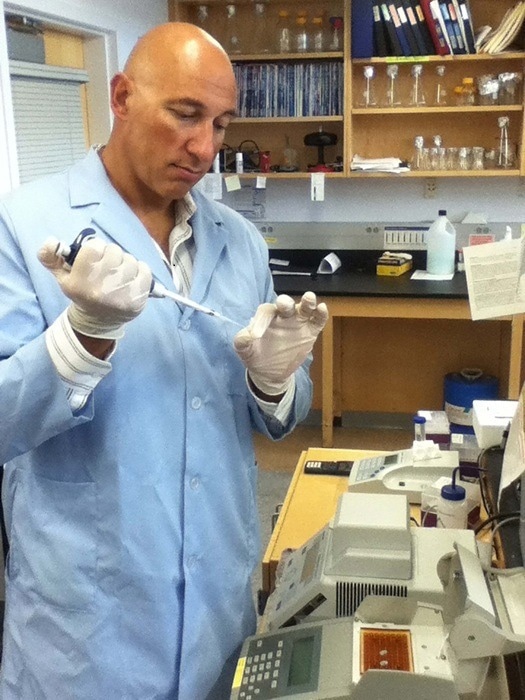Reviewed by Lexie CornerMay 14 2025
Researchers from Florida Atlantic University’s Charles E. Schmidt College of Medicine have identified a previously unrecognized mechanism that enables the human immunodeficiency virus type 1 (HIV-1) to evade the body’s immune defenses, thereby facilitating its survival and replication.
 Massimo Caputi, Ph.D., senior author and a professor in the Department of Biomedical Science, Schmidt College of Medicine. Image Credit: Florida Atlantic University
Massimo Caputi, Ph.D., senior author and a professor in the Department of Biomedical Science, Schmidt College of Medicine. Image Credit: Florida Atlantic University
The mechanism? A biological process involving circular RNAs (circRNAs), which form closed loops within cells, unlike conventional linear RNA molecules.
This circular structure increases the stability of circRNAs and allows them to act as molecular sponges, sequestering microRNAs (miRNAs) and preventing them from carrying out their usual gene regulatory functions.
Although thousands of circRNAs have been identified in human and animal cells, only a few have been found in viruses, mainly large DNA viruses such as herpesviruses, including Herpes Simplex Virus and Epstein-Barr Virus. These viruses have large genomes and the ability to remain dormant in the body for long periods.
The study, published in npj Viruses, provides the first experimental evidence that HIV-1 produces circRNAs from its integrated retroviral genome, offering a new perspective on the virus’s biology.
The findings reveal a previously overlooked element of the HIV-1 life cycle, shedding light on how the virus sustains replication, avoids immune detection, and enhances its long-term persistence. They also suggest a potential new target for future therapeutic strategies.
We have known that circular RNAs show up in DNA viruses like Epstein-Barr and the human papillomavirus, but seeing that they are generated by an RNA virus like HIV-1 is incredibly exciting. HIV-1 is unique – it integrates into the host genome and hijacks the cell’s RNA-processing machinery, giving it a rare ability among RNA viruses to generate these stable circular RNAs.
Massimo Caputi, Ph.D., Study Senior Author and Professor, Department of Biomedical Science, Schmidt College of Medicine, Florida Atlantic University
The research team identified at least 15 distinct HIV-1 circRNAs and confirmed their presence through advanced molecular techniques and sequencing methods.
When HIV infects the body, certain immune cells called CD4+ T cells respond by increasing levels of two microRNAs – miR-6727-3p and miR-4722-3p – that likely help fight the virus. But HIV seems to fight back by producing circRNAs that trap these microRNAs. This weakens the immune response and helps the virus make more copies of itself. This suggests that HIV’s circular RNAs might help keep infected cells alive and allow the virus to stay hidden in the body for a long time, one of the main reasons why HIV is so hard to cure.
Massimo Caputi, Ph.D., Study Senior Author and Professor, Department of Biomedical Science, Schmidt College of Medicine, Florida Atlantic University
Typically, certain miRNAs are present at low levels, but their concentrations rise when a person is infected with HIV. In response, HIV produces circRNAs that absorb these miRNAs, undermining the body’s defense mechanisms and allowing the virus to continue replicating.
Caputi said, “One of the most common circRNAs made by HIV, called Circ23, includes parts of the virus’s genetic code that scientists did not fully understand before. But now, they seem important for helping the virus survive and replicate.”
The findings also suggest that circRNA production may vary among individuals, potentially influencing differences in viral persistence and transmission. This variability could stem from how host cells process RNA and from the availability of RNA-binding proteins required for circRNA formation.
“These differences may help explain why patient responses vary, especially in cases of viral latency, a state where the virus lies dormant and resists both immune attack and antiretroviral therapy,” said Caputi.
Although current methods make it difficult to measure circRNAs accurately, the researchers suggest that droplet digital PCR may soon allow precise quantification of these molecules in patient samples.
This is just the beginning. We are now working to map out how these viral circular RNAs interact with human cells. If we can figure out how to block them, we might be able to stop the virus from hiding and help move closer to a cure.
Massimo Caputi, Ph.D., Study Senior Author and Professor, Department of Biomedical Science, Schmidt College of Medicine, Florida Atlantic University
The research team also plans to explore new treatments using specialized molecules called antisense oligonucleotides (ASOs) to block HIV’s circRNAs. They will test this approach in long-term infection models and in cells from individuals living with HIV to better understand how these circRNAs support the virus's persistence in the body.
Caputi said, “Our findings reveal how HIV takes control of human cells at a very detailed level and point to new possibilities for treatment. Because circular RNAs are stable and specific, they could also be used as markers of infection or as new targets for drugs.”
Source:
Journal reference:
Mauer, C., et al. (2025) Backsplicing of the HIV-1 transcript generates multiple circRNAs to promote viral replication. npj Viruses. doi.org/10.1038/s44298-025-00105-0.